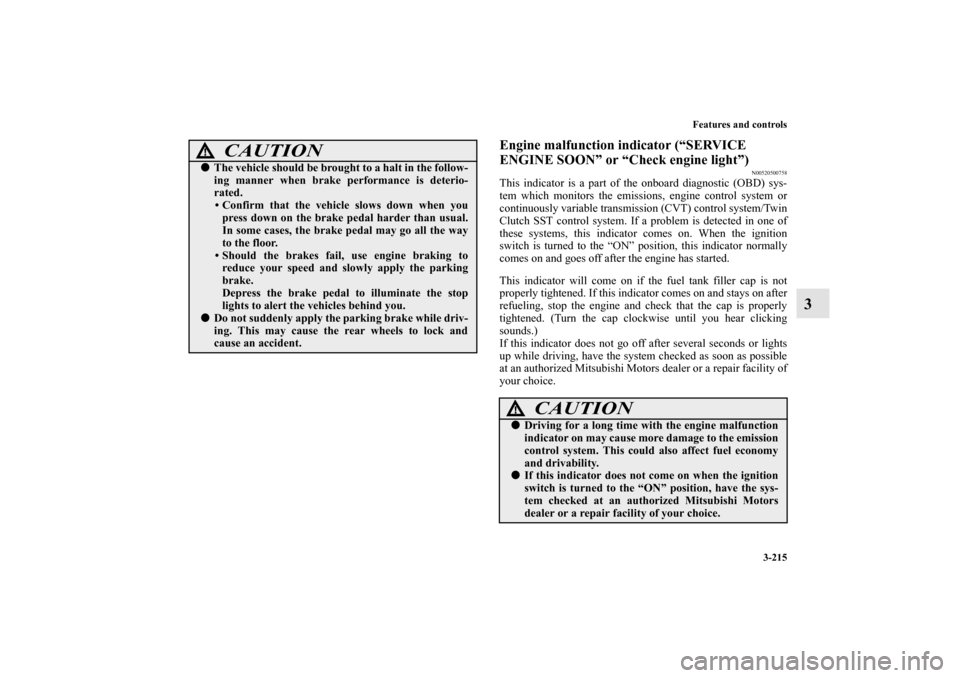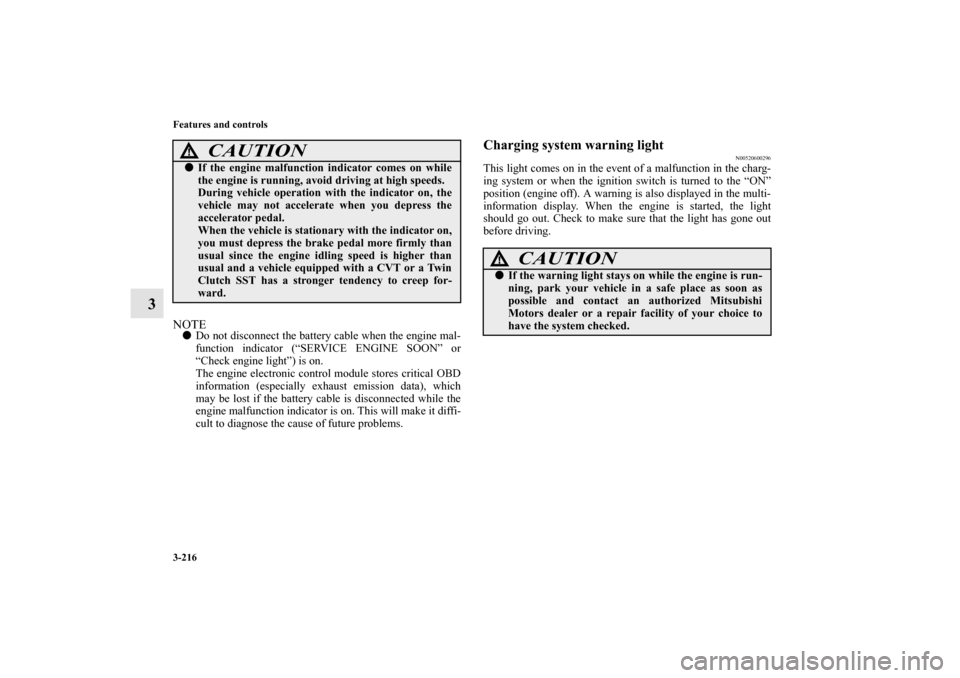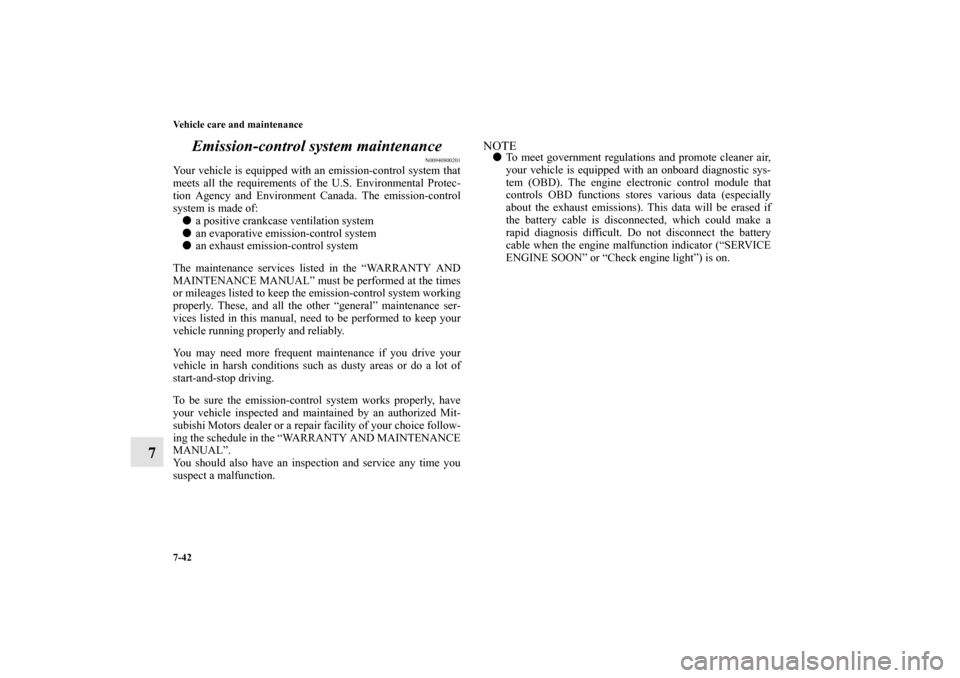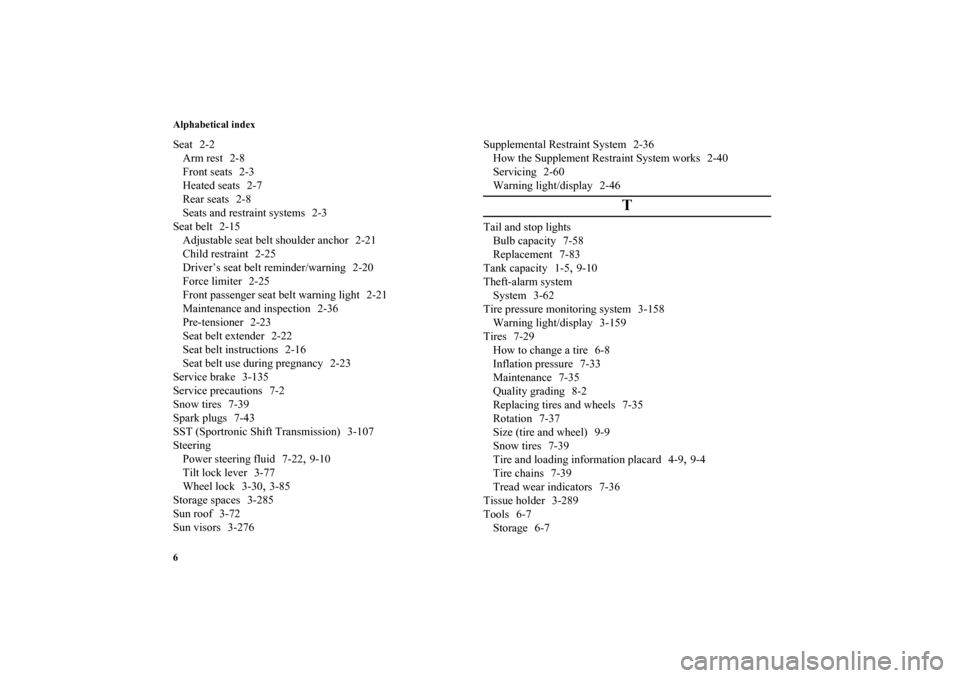Page 310 of 706

Features and controls
3-215
3
Engine malfunction indicator (“SERVICE
ENGINE SOON” or “Check engine light”)
N00520500758
This indicator is a part of the onboard diagnostic (OBD) sys-
tem which monitors the emissions, engine control system or
continuously variable transmission (CVT) control system/Twin
Clutch SST control system. If a problem is detected in one of
these systems, this indicator comes on. When the ignition
switch is turned to the “ON” position, this indicator normally
comes on and goes off after the engine has started.
This indicator will come on if the fuel tank filler cap is not
properly tightened. If this indicator comes on and stays on after
refueling, stop the engine and check that the cap is properly
tightened. (Turn the cap clockwise until you hear clicking
sounds.)
If this indicator does not go off after several seconds or lights
up while driving, have the system checked as soon as possible
at an authorized Mitsubishi Motors dealer or a repair facility of
your choice.
�The vehicle should be brought to a halt in the follow-
ing manner when brake performance is deterio-
rated.
• Confirm that the vehicle slows down when you
press down on the brake pedal harder than usual.
In some cases, the brake pedal may go all the way
to the floor.
• Should the brakes fail, use engine braking to
reduce your speed and slowly apply the parking
brake.
Depress the brake pedal to illuminate the stop
lights to alert the vehicles behind you.
�Do not suddenly apply the parking brake while driv-
ing. This may cause the rear wheels to lock and
cause an accident.
CAUTION
!
CAUTION
!�Driving for a long time with the engine malfunction
indicator on may cause more damage to the emission
control system. This could also affect fuel economy
and drivability.�If this indicator does not come on when the ignition
switch is turned to the “ON” position, have the sys-
tem checked at an authorized Mitsubishi Motors
dealer or a repair facility of your choice.
BK0125300US.book 215 ページ 2010年5月18日 火曜日 午後1時53分
Page 311 of 706

3-216 Features and controls
3
NOTE�Do not disconnect the battery cable when the engine mal-
function indicator (“SERVICE ENGINE SOON” or
“Check engine light”) is on.
The engine electronic control module stores critical OBD
information (especially exhaust emission data), which
may be lost if the battery cable is disconnected while the
engine malfunction indicator is on. This will make it diffi-
cult to diagnose the cause of future problems.
Charging system warning light
N00520600296
This light comes on in the event of a malfunction in the charg-
ing system or when the ignition switch is turned to the “ON”
position (engine off). A warning is also displayed in the multi-
information display. When the engine is started, the light
should go out. Check to make sure that the light has gone out
before driving.
�If the engine malfunction indicator comes on while
the engine is running, avoid driving at high speeds.
During vehicle operation with the indicator on, the
vehicle may not accelerate when you depress the
accelerator pedal.
When the vehicle is stationary with the indicator on,
you must depress the brake pedal more firmly than
usual since the engine idling speed is higher than
usual and a vehicle equipped with a CVT or a Twin
Clutch SST has a stronger tendency to creep for-
ward.
CAUTION
!
CAUTION
!�If the warning light stays on while the engine is run-
ning, park your vehicle in a safe place as soon as
possible and contact an authorized Mitsubishi
Motors dealer or a repair facility of your choice to
have the system checked.
BK0125300US.book 216 ページ 2010年5月18日 火曜日 午後1時53分
Page 621 of 706

7-42 Vehicle care and maintenance
7Emission-control system maintenance
N00940800201
Your vehicle is equipped with an emission-control system that
meets all the requirements of the U.S. Environmental Protec-
tion Agency and Environment Canada. The emission-control
system is made of:
�a positive crankcase ventilation system
�an evaporative emission-control system
�an exhaust emission-control system
The maintenance services listed in the “WARRANTY AND
MAINTENANCE MANUAL” must be performed at the times
or mileages listed to keep the emission-control system working
properly. These, and all the other “general” maintenance ser-
vices listed in this manual, need to be performed to keep your
vehicle running properly and reliably.
You may need more frequent maintenance if you drive your
vehicle in harsh conditions such as dusty areas or do a lot of
start-and-stop driving.
To be sure the emission-control system works properly, have
your vehicle inspected and maintained by an authorized Mit-
subishi Motors dealer or a repair facility of your choice follow-
ing the schedule in the “WARRANTY AND MAINTENANCE
MANUAL”.
You should also have an inspection and service any time you
suspect a malfunction.
NOTE�To meet government regulations and promote cleaner air,
your vehicle is equipped with an onboard diagnostic sys-
tem (OBD). The engine electronic control module that
controls OBD functions stores various data (especially
about the exhaust emissions). This data will be erased if
the battery cable is disconnected, which could make a
rapid diagnosis difficult. Do not disconnect the battery
cable when the engine malfunction indicator (“SERVICE
ENGINE SOON” or “Check engine light”) is on.
BK0125300US.book 42 ページ 2010年5月18日 火曜日 午後1時53分
Page 703 of 706

Alphabetical index
6Seat 2-2
Arm rest 2-8
Front seats 2-3
Heated seats 2-7
Rear seats 2-8
Seats and restraint systems 2-3
Seat belt 2-15
Adjustable seat belt shoulder anchor 2-21
Child restraint 2-25
Driver’s seat belt reminder/warning 2-20
Force limiter 2-25
Front passenger seat belt warning light 2-21
Maintenance and inspection 2-36
Pre-tensioner 2-23
Seat belt extender 2-22
Seat belt instructions 2-16
Seat belt use during pregnancy 2-23
Service brake 3-135
Service precautions 7-2
Snow tires 7-39
Spark plugs 7-43
SST (Sportronic Shift Transmission) 3-107
Steering
Power steering fluid 7-22
,9-10
Tilt lock lever 3-77
Wheel lock 3-30
,3-85
Storage spaces 3-285
Sun roof 3-72
Sun visors 3-276Supplemental Restraint System 2-36
How the Supplement Restraint System works 2-40
Servicing 2-60
Warning light/display 2-46
T
Tail and stop lights
Bulb capacity 7-58
Replacement 7-83
Tank capacity 1-5
,9-10
Theft-alarm system
System 3-62
Tire pressure monitoring system 3-158
Warning light/display 3-159
Tires 7-29
How to change a tire 6-8
Inflation pressure 7-33
Maintenance 7-35
Quality grading 8-2
Replacing tires and wheels 7-35
Rotation 7-37
Size (tire and wheel) 9-9
Snow tires 7-39
Tire and loading information placard 4-9
,9-4
Tire chains 7-39
Tread wear indicators 7-36
Tissue holder 3-289
Tools 6-7
Storage 6-7
BK0125300US.book 6 ページ 2010年5月18日 火曜日 午後1時53分